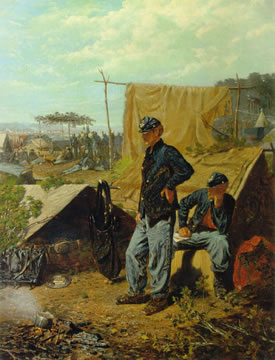Scene & Title Reunited: Other Expert References to Watching the Shot

Other Expert References to Watching the Shot
Sally Mills tells us that; Skirmish in the Wilderness is the only one of Homer’s Civil War paintings, and one of a very few early works, in which the natural landscape plays a predominant role (2.19). Mills goes on to explain; Skirmish in the Wilderness is Homer’s first painting in which the landscape plays a decidedly adversarial role (2.20). In the painting Watching the Shot the bridge, the river and the far embankment are an essential part of the painting because each of these landscape obstacles adds degrees of difficulty to the battle. What would normally have been a tranquil rural setting has been transformed by war to become an adversarial stage for this complex Civil War engagement. Without the natural elements of river, embankment and bridge, the story of the lone soldier watching the shooting of a fellow soldier could not be told (Fig. 2-8). Homer masterfully allows the natural setting to display the discourse of the battle scene.
Regarding the Homer Civil War painting Home, Sweet Home ca. 1863, (Fig. 2-9) Sally Mills relates how art critics in Homer’s time saw this painting; Critics who saw the painting in 1863 universally praised the truthfulness of Homer’s representation, the simple honesty and lack of affectation in what might easily become a cloying scene (2.21). Similarly, Watching the Shot does not present a classical battle scene, it is neither obviously heroic or romanticized, nor is it overpowering in it’s battle action. It is truthful in it’s representation of the circumstances surrounding the one watching infantryman; one soldier amongst many moving toward an uncertain fate.
Watching the Shot. © 2026 All rights reserved. Terms of Use and Privacy Policy


